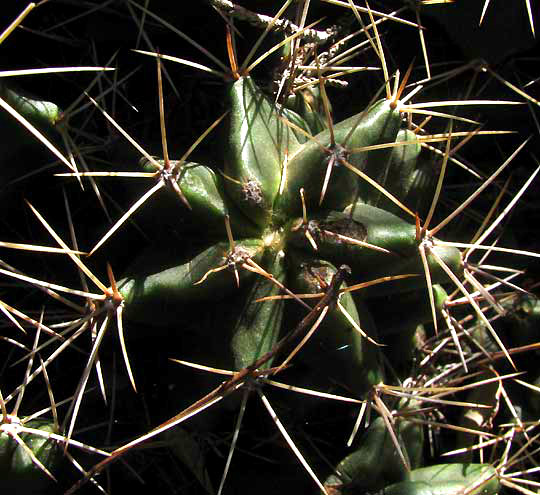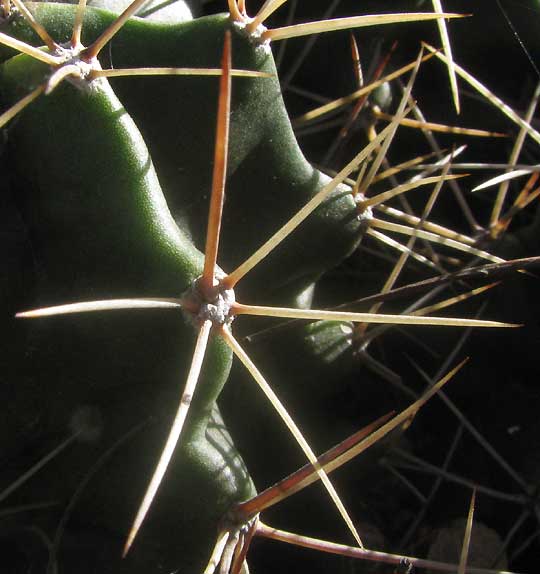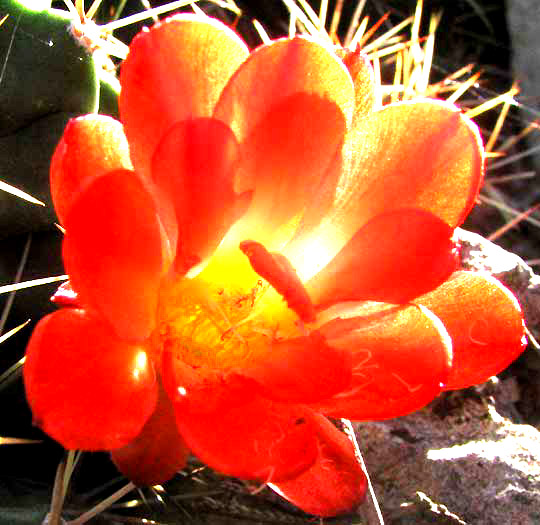Excerpts from Jim Conrad's
Naturalist Newsletter

from the March 31, 2013 Newsletter issued from the Frio Canyon Nature Education Center in northern Uvalde County, southwestern Texas, on the southern border of the Edwards Plateau; elevation ~1750m (~5750 ft); N29.62°, W99.86°; USA
CLARET-CUP CACTUS AFLAME
Atop one of many limestone hills framing the little Dry Frio River Valley within bike riding distance of here there's a cactus very unlike the usual flat-faced pricklypears so abundant in our landscape. This hilltop cactus is formed of short, branched, cylindrical stems tightly crammed into hemispherical masses the size of bushel baskets and larger, all snugly wedged between jagged limestone rocks.
This hilltop cactus has just begun flowering. On early mornings when the sunlight glares on limestone and forms cold, satiny shadows between the rocks, the cactus's blood-red flowers ignite in the sunlight like hard-burning flames, and you just stand there looking at them in wonder, sensing something transcendental taking place, feeling honored just to be there. Though my picture of this loses so much on its journey from that hilltop to you, you can get a small sense of the feeling around the cactus in the picture at the top of this page. Notice how the cactus's spines arise in star-shaped clusters distributed along "ribs" of the cactus's body.
This is ECHINOCEREUS COCCINEUS, known as the Claret-cup or Scarlet Hedgehog Cactus, distributed mainly in the Chihuahua Desert of northern Mexico, but also in southern Arizona, New Mexico and western Texas. The online Flora of North America describes it as occupying a number of habitats -- desert scrub and grasslands, pinyon-juniper and oak woodlands, Great Plains grasslands, montane forest, bajadas, rocky slopes, and cliffs, igneous, metamorphic, and limestone substrates -- and as such the species varies considerably from place to place. For instance, populations form an intergrading series from densely spine-covered ones in Colorado and northern New Mexico to sparsely spined plants in west-central Texas. The Flora says that some specimens may have as many as 22 spines per cluster, while in the picture below you can see that our plants' clusters average only six or seven:

A close-up of a single cluster is shown below:

If you are familiar with cactus anatomy you know that spines don't randomly arise from the cactus's surface, but rather from distinct roundish, often white and fuzzy locations called areoles. If you touch your finger to the areole from which spines on a pricklypear cactus arise, microscopically small spines called glochids will stick into your fingertip and may be hard to dislodge, even with tweezers. Lots of cactus types have areoles with glochids arising among their spines' bases, but Echinocereus is one genus in which there are no glochids. That's a wonderful feature for those of us with the urge to poke cacti with our fingers.
Below you can see a Claret-cup blossom catching its share of sunlight:

While confirming our cactus's identity by keying it out in the genus key of the Flora of North America, there's a point early in the key where the keyer must judge whether the blossom of the specimen being examined displays the "hummingbird pollination syndrome" or the "bee pollination syndrome."
Blossoms subscribing to the hummingbird pollination syndrome display one or more of the following features: flower centers that are mainly red or reddish; the tepals (flower's colored parts) are stiff enough for a hummingbird to perch on; tepals more or less rounded; flowers have pink to yellowish-purple anthers; inner stamens are longer than outer ones; innermost stamens unite at their bases to form nectar chambers, and; flowers remain open at night and in cold temperatures.
Blossoms displaying the bee pollination syndrome often have one or more of the following characteristics: yellow to brownish or pink to purple centers; tepals usually somewhat pointed and/or thin and delicate; anthers yellowish; inner stamens shorter than outer and don't unite at their bases to form a nectar chamber, and; the flowers partly or completely close at night and during cold temperatures.
The Claret-cup keys out as employing the hummingbird pollination syndrome.